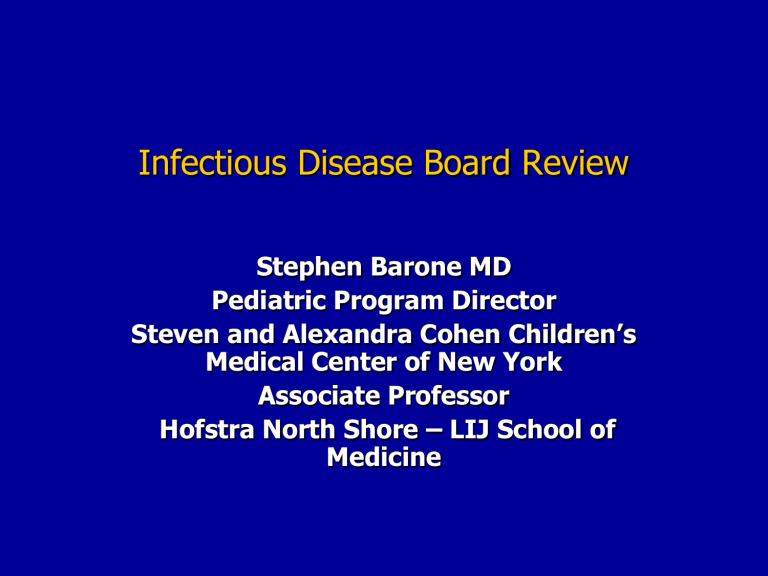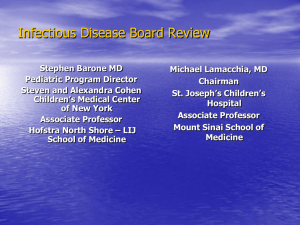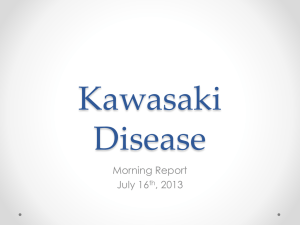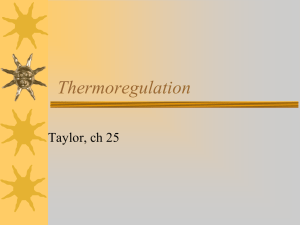Document

Infectious Disease Board Review
Stephen Barone MD
Pediatric Program Director
Steven and Alexandra Cohen Children’s
Medical Center of New York
Associate Professor
Hofstra North Shore – LIJ School of
Medicine
Question 1
A healthy 3 year old presents with a fever to 39.8 and stridor. The child reportedly has had a 3 –day history of a “bark-like” cough, low grade fever and
URI symptoms. She became acutely worse today and appears “toxic” . The most likely diagnosis is?
A.
Viral laryngotracheitis
B.
Epiglottis
C.
Retropharyngeal abscess
D.
Foreign body
E.
Bacterial tracheitis
0%
A.
0%
B.
0%
C.
0%
D.
0%
E.
6
Key Points # 1
•
Bacterial tracheitis
– Fever, toxic, stridor, secretions, S aureus
•
Epiglottis
– Older, unimmunized, drooling , toxic, no cough, H. Influenza
•
Viral laryngotrachitis
– Cough, stridor, non-toxic, parainfluenza
•
Retropharyngeal abscess
– Young, drooling, stiff neck
•
Foreign body
– Acute onset, afebrile, historical clues
Question 2
A 2 month old infant presents with a 2 -week history of a cough and perioral cyanosis. The treatment of choice is?
A.
High dose
Amoxicillin
B.
Azithromycin
C.
Clindamycin
D.
Steroids
E.
Trimethroprim sulfamethoxazole
0%
A.
0%
B.
0%
C.
0%
D.
0%
E.
6
Key Point #2
•
Pertussis
– Infants or Adolescents
– Macrolide - limit spread
•
Differential Diagnosis
– Chlamydia trachomatis
• Staccato cough, tachypnea afebrile,
– PCP
• Hypoxic, toxic , immunodeficiency
Question 3
A 5 year-old presents with migratory arthritis and this rapidly changing rash. The most likely diagnosis is?
A.
Fifth disease
B.
Juvenile rheumatoid arthritis
C.
Rheumatic fever
D.
Systemic Lupus
E.
Lyme Disease
0%
A.
0%
B.
0%
C.
0%
D.
0%
E.
6
Key Points #3
•
Group A Streptococcus infections
– Exudative pharyngitis, fever, anterior nodes
– Rheumatic fever
• Arthritis, chorea, carditis, nodules, erythema marginatum
• Prophylaxis
• Scarlet fever – no prophylaxis
– PSGN
• Skin infections, not preventable with antibiotics
Question 4
An afebrile 12 year boy with nephrotic syndrome presents with a headache, vomiting and 6 th nerve palsy. His sensorium is intact. The most likely diagnosis is?
1.
Meningitis
2.
Sinus venous thrombus
3.
Brain abscess
4.
Sinusitis
5.
Lyme Disease
0%
1
0%
2
0%
3
0%
4
0%
5
6
Key Points #4
• Sinus Venous Thrombosis
– Symptoms
• Headache
• Weakness
• Seizures
– Predisposing conditions
• Nephrotic syndrome
• Thrombophilia
• Meningitis
• Dehydration
Question 5
A child entering kindergarten has had multiple episodes of otitis media and a second episode of radiographically documented pneumonia. What is the most appropriate initial test for a possible immunodeficiency?
A.
Serum complement levels
B.
Serum immunoglobulin levels
C.
CD4/CD8 ratio
D.
Serum IgE levels
E.
Serial complete blood counts for 6 weeks
0%
A.
0%
B.
0%
C.
0%
D.
0%
E.
6
Key Points #5
•
AOM and Pneumonia
– Encapsulated organisms
•
Immunoglobulin Deficiency
– X – Linked Agammaglobulinemia
– Common Variable Immunodeficiency
– IgA immunodeficiency
•
Screening Tests
– Immunoglobulins
– Response to vaccines
Question 6
A 3 year old presents with a 1 month history of unilateral cervical adenitis. The child has been well appearing, afebrile and has had not traveled. A PPD measures 6 mm. The next step in the management is?
A.
Isoniazid and
Rifampin for 6 months
B.
A repeat PPD in 3 months
C.
A CT of the neck
D.
Excisional biopsy
E.
Azithromycin for 4 weeks
0%
A.
0%
B.
0%
C.
0%
D.
0%
E.
6
Key Points #6
• Unilateral adenitis
– Acute
• S. aureus, Group A Streptococcus
– Antibiotics
– Sub acute
• Atypical Mycobacterium
– History, PPD, excisional biopsy
• Cat Scratch
– History, serology, no treatment
• Kawasaki Disease
– IVIG
– Chronic
• Malignancy
Question 7
A 15 year old boy develops a fever to 101 o F, headache and bilateral swelling of his parotid glands. The most likely complication of this illness is?
A.
Acute airway obstruction
B.
Sensorineural hearing loss
C.
Orchitis
D.
Myocarditis
E.
Arthritis
0%
A.
0%
B.
0%
C.
0%
D.
0%
E.
6
Key Points #7
• Parotitis
– Bacterial – ill appearing
– Viral
• Mumps
– Viral syndrome with swelling of parotid glands
– Complication
• Orchitis
• CSF pleocytosis – most asymptomatic
• Rare – myocarditis, arthritis etc.
• Vaccine
– Live vaccine
Question 8
A 15 year old complains of a sore throat, fever and a muffled voice. On examination the adolescent is found to have trismus. The most likely diagnosis is?
1.
Tetanus
2.
Retropharyngeal abscess
3.
Infectious mononucleosis
4.
Peritonsillar abscess
5.
Herpangia
0%
1
0%
2
0%
3
0%
4
0%
5
6
Key Points #8
• Peritonsillar abscesses
– Adolescent, sore throat, hot potato voice, trismus
• Dx – exam
• Organisms –S. aureus. Group A Streptococcus, Anaerobes
• Retropharyngeal abscess
– Toddler, stridor, stiff neck, dysphagia, torticollis
• Dx – CT scan
• Infectious Mononucleosis
– Adolescent, sore throat, lymphadepathy, fatigue, fever
• Tetanus
– Trismus and muscle spasm
– Treatment
• Penicillin
• Herpangina
– Peritonsillar ulcers/vesicles
– Enteroviral infection
Question 9
A 9 month old presents with vesicular lesions on his lips and bleeding gums. He is drooling and unable to eat. There is a
“target lesion rash” In addition to hydration, Which therapeutic regime will be most effective?
A.
IV acyclovir
B.
IV nafcillin
C.
Topical nystatin
D.
Topical mupirocin
E.
IV steroids
0%
A.
0%
B.
0%
C.
0%
D.
0%
E.
6
Key Points #9
• Herpes gingivostomatitis
– Young child, anterior vesicles, swollen gums
– Treatment – supportive, Acyclovir
– Complication – erythema multiforme
– Dx – Culture, DFA
• Herpangina
– Posterior vesicles
• Candida
– Cottage cheese plaques on buccal mucosa
• Impetigo
– Honey crust lesions on the skin
– Group A Streptococcus, S. aureus
Question 10
A 3 year old presents with a three day history of fever and cough. Today he developed respiratory distress. In addition to supportive care what is the most appropriate treatment plan?
A.
CT Scan of chest
B.
Ceftriaxone
C.
PPD
D.
Bronchoscopy
E.
Amphotericin
0%
A.
0%
B.
0%
C.
0%
D.
0%
E.
6
Key Points #10
•
Pneumococcal pneumonia
– Most common bacterial pneumonia
– Acute, fever, tachypnea, cough, focal infiltrate
• Round pneumonia
– Treatment
• Inpatient – Ceftriaxone
• Outpatient – High dose Amoxicillin
• Resistance – Lack of PCP’s
Question 11
A 3 year old presents with a month history of cough, fever and weigh loss. His CXR demonstrates a focal infiltrate with hilar lymphadenopathy. A PPD measures 7 mm. The most appropriate treatment plan is?
A.
Repeat PPD in 3 months
B.
Bronchoscopy
C.
Gastric lavage
D.
Isoniazid for nine months
E.
Isoniazid, Rifampin and Ethambutal for 6 months
0%
A.
0%
B.
0%
C.
0%
D.
0%
E.
6
Key Points # 11
• Mycobacterium tuberculosis
– History
• Immigrant, insidious, weight loss, hilar nodes
– PPD
• 5 mm – high risk – symptoms, HIV
• 10 mm – medium – age less than 6, immigrant, travel
• 15 mm – low
• Diagnosis – gastric lavage
– Treatment
• Four drugs then based on sensitivities
– Side-effects
• Prophylaxis
– INH – 9 months
Question 12
A ten year old boy presents in December with a four day history of cough, fever and myalgia. Today he became acutely worse and is in respiratory distress. The most appropriate therapy is?
A.
Oseltamivir
B.
Ribavirin
C.
Clindamycin
D.
Aztreonam
E.
Azithromycin
0%
A.
0%
B.
0%
C.
0%
D.
0%
E.
6
Key Points #12
•
Influenza
– Fever, cough, myalgia
– Oseltamivir – within 48 hours
– Influenza vaccine – 2A, 1B
– Antigenic shift vs. antigenic drift
•
Complications
– S. aureus pneumonia
• MRSA
– Clindamycin, Vancomycin
Question 13
A febrile irritable 20 month old male presents with a two day history of a “crusty” excoriation under his nose
This was followed by a diffuse erythematous painful rash. The most likely diagnosis is?
A.
Kawasaki disease
B.
Staphylococcal scalded skin syndrome
C.
Toxic shock syndrome
D.
Roseola
E.
Enteroviral infection
0%
A.
0%
B.
0%
C.
0%
D.
0%
E.
6
Key Points #13
1.
Staphylococcal Scalded Skin
Syndrome
1.
Symptoms
1. Non-toxic, impetigo, painful, sunburn rash, skin peels readily.
2.
Toxic Shock Syndrome
1.
Hypotension
2.
Fever
3.
Rash
4.
Desquamation
1. Plus three or more organ systems involved
Question 14
A 10 year boy presents to a Maryland ED with a 3 day history of shaking chills, myalgia, and abdominal pain. He is noted to have this rash on his feet and splenomegaly. The most likely diagnosis is?
A.
Meningococcemia
B.
HSP
C.
RMSF
D.
Lyme disease
E.
EBV
0%
A.
0%
B.
0%
C.
0%
D.
0%
E.
6
Key Points # 14
•
Rocky Mountain Spotted Fever
– Epidemiology, distal petiechiae, headache, increased LFT’s, hyponatremia
• Treatment – doxycycline
•
Lyme Disease
– Northeast, Wisconsin, Northern CA
• Rash, arthritis (mono), meningitis
– Treatment
Amoxicillin, Doxycycline
Ceftriaxone
Question 15
A year old child presents with a four day history of irritability and recurrent fevers. Today he is afebrile and had a diffuse erythematous rash on his trunk. You diagnosis the child with roseola. Which of the following is a common complication of this disease?
A.
Arthritis
B.
Febrile seizures
C.
Aseptic meningitis
D.
Thrombocytopenia
E.
Hepatitis
0%
A.
0%
B.
0%
C.
0%
D.
0%
E.
6
Key Points # 15
• Roseola
– Fever followed by rash
• HHV6 infection
– Complications
• Febrile seizures
• Complications
– Parvovirus – arthritis
– EBV – hepatitis
– Aseptic meningitis – Kawasaki
– Thrombocytopenia - RMSF
Question 16
A premature 11 month old infant receives a dose of palvizumab for prophylaxis against RSV infection. When should the next dose of MMR vaccine be administered?
A.
1 month
B.
3 months
C.
6 months
D.
9 months
E.
One year
0%
A.
0%
B.
0%
C.
0%
D.
0%
E.
6
Key Point #16
• MMR Vaccine – Live vaccine
– Intervals
• Palivizumab - None
• PRBC – 5 months
• IVIG – 11 months
• Fun facts
– Not contraindicated with egg allergy
– PPD suppressed for 6 weeks
– If greater then 2/kg steroids – wait one month
– No effect of inadvertent MMR on pregnancy
Question 17
A 16 year old boy who has recently immigrated from El Salvador presents to the ED with a new – onset seizure. The MRI reveals an multiple 2-3 mm spherical lesions. The most appropriate diagnostic test is?
1.
Stool O and P
2.
Serological studies for
T. Solium
3.
PPD
4.
Lumbar puncture for oligoclonal bands
5.
Brain biopsy
0%
1
0%
2
0%
3
0%
4
0%
5
6
Key Point #17
•
Cysticercosis
–
T. Solium
• Ingesting eggs – fecal – oral route
– New onset seizures
• Mexico, Latin America
• Characteristic MRI
• Diagnosis with serology
– Treatment - Praziquantel
Question 18
A fourteen year old male presents to the ED after sustaining a laceration with a lawn motor blade. He has not received any vaccinations in the past 5 years. Although his mother reports he received all recommended immunizations as a child. He should receive?
A.
Td and TIG
B.
TdaP
C.
DT
D.
TdaP and TIG
E.
TIG
0%
A.
0%
B.
0%
C.
0%
D.
0%
E.
6
Key Points # 18
No Contraindication
DTaP – under 7
TdaP – Adolescents
Contraindication
Td – greater than 7
DT – less than 7
Vaccine Clean
V/TIG
Unknown or < 3 doses
Y / N
Dirty
V/TIG
Y / Y
3+ doses
Y / N
If > 10 yrs
Y / N
If > 5 yrs
V = vaccine
Question 19
Which of these two vaccine pairs, if not given simultaneously (at the same visit) should be separated by at four least weeks?
A.
Hepatitis A and
Hepatitis B
B.
IPV and
Pneumococcal
C.
DTaP and Hib
D.
MMR and Varicella
E.
MMR and
Hepatitis B
0%
A.
0%
B.
0%
C.
0%
D.
0%
E.
6
Key Points #19
•
Live vaccines if not given simultaneously need to be separated by 4 weeks
– Learn contraindications of live vaccines
•
“egg based” vaccines
– Influenza (injectable)
– Yellow fever
– Measles and mumps (chick embryo)
Question 20
A 5 year old presents with fever, jaundice and vomiting. A hepatitis profile reveals: Hepatitis A IgM – negative.
Hepatitis A IgG- positive. Hepatitis BsAg –negative. Hepatitis
BsAb – positive. Hepatitis BcAb – negative. Interpretation?
A.
Acute hepatitis A and B infections
B.
Chronic hepatitis A and B infections
C.
Previous vaccination against hepatitis A and B
D.
Chronic hepatitis B infection and acute hepatitis B infection
E.
Past hepatitis B infection and acute hepatitis B infections
0% 0% 0% 0%
A.
B.
C.
D.
0%
E.
6
Key Points #20
• Hepatitis A
IgM – Acute
IgG – Acute, past, vaccine
BsAg
BcAb
BsAb
BsAg
BcAb
BsAb
BsAg
BcAb
BsAb
BsAg
BcAb
BsAb
Tests Results
Negative
Negative
Positive
Negative
Positive
Positive
Positive
Positive
Negative
Positive
Positive
Negative
Interpretation
Vaccine
Past infection
Acute infection
Chronic infection
Question 21
A 14 year old boy presents with a 10 day history of foul smelling watery diarrhea and abdominal pain.
What is the most likely cause of his symptoms?
A.
Norwalk virus
B.
Giardia
C.
Campylobacter
D.
Yesinia
E.
Helicobacter
0%
A.
0%
B.
0%
C.
0%
D.
0%
E.
6
Key Points # 21
• Small intestine
– Watery, high volume, frequent
• Rotavirus. Norwalk, Adenoviurs, Giardia
• Large Intestine
– Blood, small volume, mucus, travel
• Salmonella – food, turtles
• Campylocbacter – unpasteurized milk, GBS
• Yersina – “chittlings”
• Shigella – food, neurotoxin
• E-coli O157H7- food, HUS
• E-coli – travel associated – watery
• C. difficle - antibiotics
Question 22
An 12 year old returns from a three month trip to India. She complains of a 10 day history of fever, chills, abdominal pain and myalgia. Her examination is unremarkable
Lab results WBC – 6,000 Hb – 13.6 Plt – 400,000 AST – 120
Her most likely diagnosis is?
A.
Malaria
B.
Typhoid fever
C.
TB
D.
Hepatitis B
E.
Yellow fever
0%
A.
0%
B.
0%
C.
0%
D.
0%
E.
6
Key Points #22
• Malaria
– Fever, splenomegaly, hemolytic anemia
• Typhoid
– Flu- like illness, normal WBC
• TB
– Longer incubation period
• Hepatitis B
– No risk factor for traveling adolescents
• Yellow fever
– Africa, South America
Question 23
Which is the preferred diagnostic test to confirm an HIV infection in one month old infant born to an HIV positive mother?
A.
HIV p24 antigen assay
B.
HIV DNA PCR
C.
HIV culture
D.
HIV serology
E.
CD4/CD8 ratio
0%
A.
0%
B.
0%
C.
0%
D.
0%
E.
6
Key Points #23
– HIV serology can be falsely positive for up to
18 months after birth
– HIV p24 antigen test – false positives and negatives
• Not recommended
– HIV culture – requires 4 weeks, not readily available
• Not recommended
– HIV DNA PCR
• Highly sensitive and specific
• Considered infected if two separate positive tests
– CD4/CD8 ratio
• Not useful in the neonatal period
Question 24
An infant was born to a 26-year old female with a history of syphilis during the first trimester of pregnancy, as evidenced
VDRL result (titer 1:8). The woman received one injection of
2.4 million units of benzathine penicillin. At delivery, her VDRL had a titer of 1:64.
In evaluating this infant the appropriate conclusion is that -
A.
The infant requires no further therapy
B.
The infant has a high probability of having congenital syphilis
C.
If the infant’s long bone radiographs show no abnormality, no treatment is indicated
D.
This child may be given a shot of benzathine penicillin, and no further serologic evaluation is necessary
0%
A.
0%
B.
0%
C.
0%
D.
6
Key Points #24
Evaluate infants for congenital syphilis if:
• Fourfold increase in maternal titer
• Infant has clinical manifestations of syphilis
• Syphilis is untreated, inadequately treated, or treatment not documented
• Mother treated with non-penicillin regimen
• Mother treated <1 month before delivery
• Treated before pregnancy but with insufficient serologic follow-up
Evaluation for syphilis in an infant:
• Quantitative nontreponemal serologic test of serum from infant
• VDRL test of CSF, cell count, protein concentration
• Long-bone Xrays
• CBC w/platelets
Question 25
A 10-year-old child develops ascending paralysis with peripheral neuropathy (cranial nerves are normal); the CSF is normal except for an elevated protein level. The likely infectious agent precipitating this syndrome is -
A.
Corynebacterium diphtheriae
B.
Clostridium botulinum
C.
S. dysenteriae serotype 1
D.
Campylobacter jejuni
E.
Clostridium tetani
0%
A.
0%
B.
0%
C.
0%
D.
0%
E.
6
Keypoints #25
•
Guillain-Barre Syndrome
•
Motor polyradiculoneuropathy
• Muscle pain, symmetric, ascending paresis, areflexia
• Relative symmetry, mild or no sensory,
• Cranial nerve involvement, autonomic dysfunction
• Absence of fever
• CSF features
Elevated protein after first week
Fewer than 10 mononuclear cells
• Electrodiagnostic features
Nerve conduction slowing
• Etiology:
Campylobacter jejuni, CMV, EBV, M. pneumoniae
Question 26
A newborn infant is found to have microcephaly, jaundice and petechiae at birth. A head CT is as shown. This child should be followed serially by what modality?
1.
A. Hearing evaluations
2.
B. Ophthalmologic evaluations
3.
C. CSF examinations
4.
D. CBCs
5.
E. Peripheral titers
0%
1
0%
2
0%
3
0%
4
0%
5
6
Keypoint #26
•
Congenital CMV
•
90% asymptomatic at birth
• IUGR,
• Jaundice,
• Microcephaly,
•
HSM,
•
Intracerebral calcifications (perventicular) vs. Toxo
• Test – Urine viral culture
•
Asymptomatic – 90% go onto develop sensorineural hearing loss
Question 27
A 4-year-old male is brought to your office because of a circular reddish rash. The child has been afebrile and has had no other systemic symptoms. The rash is not pruritic. The child’s parents state that they have recently returned from visiting relatives in Wisconsin.
The only abnormality on the examination is the circular, flat, erythematous rash that is about 6 cm in diameter and is not tender.
The appropriate next step in treating this patient is to -
A.
Order a test for serum antibodies against Borrelia burgdorferi
B.
Begin treatment with doxycycline
C.
Begin treatment with amoxicillin
D.
Begin treatment with ceftriaxone
E.
Perform a lumbar puncture to be certain that the child’s central nervous system (CNS) is not involved.
0% 0% 0% 0%
A.
B.
C.
D.
0%
E.
6
Keypoint # 27
• Clinical
– Early localized
• Erythema migrans
– Early disseminated
• Multiple erythema migrans
• Cranial nerve palsies
• Lymphocytic meningitis
• Arthritis
• Carditis
– Late Recurrent
• Arthritis
• CNS
• Diagnosis
– Clinical (EM) during early stages
– Clinical and serologic in early disseminated or late
– Serology
EIA or IFA for screening
Western Immunoblot
1 gG 5 bands
1 gM 2 bands
Question 28
Primary pulmonary histoplasmosis in normal children is usually?
A.
Asymptomatic
B.
Associated with severe flu-like symptoms
C.
Treated with assisted ventilation and steroid therapy
D.
Associated with sarcoidlike disease
E.
Complicated by mediastinal fibrosis
0%
A.
0%
B.
0%
C.
0%
D.
0%
E.
6
Keypoint #28
Histoplasmosis
•
Causes symptoms in fewer than 5% of infected people
•
Site (pulmonary, extrapulmonary, disseminated)
•
Mississippi, Ohio, Missouri River Valley
Coccidiomycosis
• Asymptomatic or self-limited 60%
•
May resemble influenza, diffuse erythematous maculopapular rash, erythema multiforme, erythema nodosum
•
Dissemination to skin, bones, joints, CNS is rare
•
California, Arizona, New Mexico, Texas, Utah, northern New Mexico, certain areas of Central and South America
Blastomycosis
• May be asymptomatic or acute, chronic or fulminant disease
•
Pulmonary and cutaneous lesions
•
Can disseminate to bones, CNS, abdominal viscera, kidneys
• Southeastern and central states and those bordering Great Lakes
Question 29
All of the following are consistent with the diagnosis of congenital toxoplasmosis in an infant EXCEPT -
A.
An infant with normal findings on newborn evaluation
B.
An infant who is small for gestational age
C.
A CSF protein level of 3 g/dL
D.
An infant whose mother has no serologic evidence of
Toxoplasma gondii infection
E.
An infant who mother has
AIDS and is chronically infected with T. gondii
0%
A.
0%
B.
0%
C.
0%
D.
0%
E.
6
Key Points # 29
• Congenital Toxoplasmosis
– Asymptomatic at birth 70-90%
– Many will go on to have visual impairment, learning disabilities, mental retardation
– At birth, may have maculopapular rash, generalized lymphadenopathy, hepatomegaly, splenomegaly, jaundice, thrombocytopenia
– CNS manifestations: hydrocephalus, microcephaly, chorioretinitis, seizures, deafness
– Cerebral calcifications are diffuse
– Members of cat family are definitive hosts
Question 30
A 5-month-old previously healthy female is brought to her pediatrician because of fever, irritability, and poor feeding.
She is the second child in her daycare center to be diagnosed with meningitis within a week. She has received all recommended immunizations. The most likely cause of her meningitis is -
A.
Haemophilus influenzae
B.
Neisseria meningitidis
C.
Group B streptococci
D.
Herpes simplex virus
E.
Listeria monocytogenes
0% 0% 0% 0%
A.
B.
C.
D.
0%
E.
6
Key Points # 30
• Neisseria Meningitidis
– Children younger than 5, greatest attack rate in less than
1 year
– Adolescents 15-18 years
– Freshmen college students who live in dormitories
– Close contacts of patients with meningococcal disease
• Deficiency of terminal complement, properdin, or anatomic or functional asplenia
• Meningococcemia, meningitis
– Waterhouse-Friderichsen-purpura, DIC, shock, coma, death
• Vaccine
– A, C, Y, W135 – no B
Question 31
Which of these organisms is typically sensitive to cephalosporins?
A.
Enterococcus
B.
Proteus mirabilis
C.
Listeria monocytogenes
D.
Pasteurella multicida
E.
Bacteroides fragilis
0%
A.
0%
B.
0%
C.
0%
D.
0%
E.
6
Keypoint #31
Proteus mirabilis is usually susceptible to cephalosporins
Enterococcus Ampicillin, Vancomycin
Listeria monocytogenes Ampicillin
Pasteurella multicida Penicillins
Bacteroides fragilis metronidazole, cabapenems, beta-lactam/beta-lactamase inhibiter
Question 32
A 10 day old infant presents with fever, irritability, decreased po feeding and poor capillary refill. The infants vital signs are
Temp 39.0 HR 180 RR 26 B/P 60/25. The baby was born full term without any complications . In addition to ampicillin and ceftriaxone the infant should be treated with?
A.
Vancomycin
B.
Acyclovir
C.
IVIV
D.
Prostacyclin
E.
Azithromycin
0%
A.
0%
B.
0%
C.
0%
D.
0%
E.
6
Key Points # 32
• Neonatal Herpes Infections
– As common as bacterial meningitis
– Risk of HSV infection at delivery in an infant born vaginally to a mother with primary infection of 33-50%
– If born to a mother with reactivated infection of less than 5%
– Neonatal HSV may be –
1) disseminated
2) localized to CNS
3) localized to skin, eyes, mouth
Question 33
A 5 year old child presents to the emergency department 12 hours after receiving a dog bite to his hand. The hand is swollen, red and painful. The intravenous antibiotic of choice is?
A.
Ceftriaxone
B.
Doxycycline
C.
Clindamycin
D.
Ampicillin –
Sulbactam
E.
Erythromycin
0%
A.
0%
B.
0%
C.
0%
D.
0%
E.
6
Key Points # 33
•
Animal Bites
– Pasteurella multicida – rapid < 24h hours
– Staphylococcus aureus
– Mixed Infections
•
P. multicida
– Drug of choice - penicillin
– Resistant to many cephlosporins
Question 34
An 17 year old sexually active female presents to the ED complaining of malodorous, frothy vaginal discharge. A wet mount is as shown. The drug of choice is?
A.
Ceftriaxone
B.
Clindamycin
C.
Metronidazole
D.
Fluconazole
E.
Azthromycin
0%
A.
0%
B.
0%
C.
0%
D.
0%
E.
6
Key Points # 34
• Trichomonas Vaginalis
– Asymptomatic in 90% of men and 50% of women
– Frothy vaginal discharge and mild vulvovaginal itching and burning, pale-yellow to green-gray
DC, musty odor
– Deeply erythematous vaginal mucousa, friable cervix
– Wet-mount prep
– Metronidazole or Tinidazole
Question 35
A 15 year old girl had sexual intercourse for the first time a week ago. She has received 3 doses of the quadrivalent HPV vaccine. Which of the following statements are true?
A.
Secondary to “cross protection” she is protected from all strains of HPV
B.
She is fully protected against HPV related cervical cancer
C.
She has a decreased risk of developing genital warts
D.
She should receive a booster dose now.
E.
If her partner used a condom her risk for HPV is reduced by 95%
0%
A.
0%
B.
0%
C.
0%
D.
0%
E.
6
Key Points # 35
•
Human Papilloma Virus
– Condylomata Acuminata – skin colored warts with a cauliflower-like surface
– HPV the cause of cervical, vulvar, vaginal cancers
– HPV Vaccine
• 16, 18 cervical cancer – 67% decrease
• 6,11 cervical warts – 98% decrease
Question 36
Abdominal pain and bloody diarrhea develop in a 2year-old boy two days after completion of therapy for otitis media. The child is febrile and has abdominal distention. An assay for C. difficile toxin in positive. The most appropriate next step in the management of this child is?
A.
Confirmatory stool culture for C. difficile
B.
A colonoscopy to determine the extent of the disease
C.
Initiation of oral metronidazole
D.
Initiation of oral
Vancomycin
E.
Initiation of IV Vancomycin
0%
A.
0%
B.
0%
C.
0%
D.
0%
E.
6
Key Points # 36
• C. Difficile
– Pseudomembranous colitis – diarrhea, abdominal cramps, fever, systemic toxicity, abdominal tenderness, stools with blood and mucous
– At risk groups for severe or fatal disease are: leukemics with fever and neutropenia, Hirschsprung, IBD
– Diagnosis
• C. Difficle toxin
• Infants have greater than 50% positivity
– Treatment
• Discontinue antibiotics
• Oral metronidazole,
• In severe disease, if diarrhea persists –vancomycin
Question 37
A 10 day old infant presents with fever and irritability. The infant’s mother was ill with fever, malaise and abdominal pain 7 days prior to delivery. She reports her Group B strep status as negative. A lumbar puncture revealed a RBC count of 50 and a
WBC count of 2,500.
The most likely organism causing this child’s meningitis is?
A.
Group B streptococcus
B.
Escherichia coli
C.
Listeria monocytogenes
D.
Enterviral
E.
Herpes Simplex
0%
A.
0%
B.
0%
C.
0%
D.
0%
E.
6
Key Points # 37
•
Listeria monocytogenes
– Infections associated with maternal flu like illness, fever, malaise, GI symptoms
– Early or late onset
• Early – preterm, pneumonia, sepsis
• Late - Meningitis
Question 38
A nurse reports 2 week old infant born at a gestational age of
33 weeks is no longer moving his right leg. An x-ray of the child’s leg reveals a lytic lesion in his femur and tibia. The most likely etiologic agent is?
A.
Group B streptococcus
B.
S. aureus
C.
S. epidermidis
D.
Pseudomonas aeruginosa
E.
Kingella kingae
0%
A.
0%
B.
0%
C.
0%
D.
0%
E.
6
Key Points # 38
•
Neonatal Osteomylitis
– Most likely – Group B streptococcus
• Multifocal
• Pseudo-paralysis
• Afebrile
Question 39
An adolescent patient with ALL is being treated for prolonged fever and neutropenia. On a routine set of electrolytes it is noted that her serum potassium is 2.0.
Which of the following drugs is most likely the cause of this patient’s hypokalemia?
A.
Vancomycin
B.
Amphotericin
C.
Cefepine
D.
Acyclovir
E.
Gentamicin
0%
A.
0%
B.
0%
C.
0%
D.
0%
E.
6
Key Points # 39
•
Complications of Amphotericin
– Systemic
• Fever, Chills
– Renal
• Azotemia
• Hypokalemia
– Essentially any other system as some potential side - effects
Question 40
A 6 month old is admitted to the hospital for elective tonsillectomy . During your history and physical examination the mother reports he was expose to varicella at day care 48 hours ago. At this time you should?
A.
Place the baby on respiratory isolation
B.
Place the baby on respiratory isolation and administer VZIG
C.
Place the baby on respiratory isolation and administer both the varicella vaccine and
VZIG
D.
Administer VZIG only and reschedule the surgery
E.
No special precautions
0%
A.
0%
B.
0%
C.
0%
D.
0%
E.
6
Key Points # 40
•
Varicella
– Incubation 7 to 21 days
•
Indications for VZIG
– Immunocompromised
– Newborn- mothers onset 5 days before to 2 days afterward
– Preterm infant < 28 weeks
• Exposure
– Household
– Face to face play
– Hospital – same room, face to face contact









